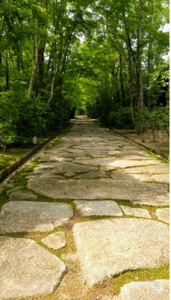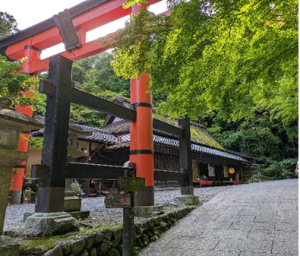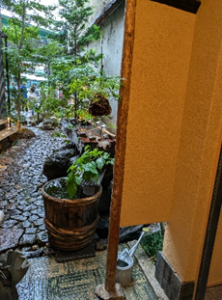(日本語) 道
Yoshie Doi
 A road on the grounds of Aman Kyoto, photographed on August 5, 2020 |
 The road in front of Saga Toriimoto Hiranoya, photographed on June 8, 2024 |
 From the entrance of Gion Izuju, photographed on July 23, 2024 |
AMAN Kyoto https://www.aman.com/ja-jp/resorts/aman-kyoto
Hiranoya https://ayuchaya-hiranoya.com/
Kyoto has alleyways and big roads, but these three are my favorites. Speaking of roads, there is a famous painting of a road by painter Kaii Higashiyama. It is a single road that calms the mind. In 1950, Tanesashi Beach in Hachinohe City, Aomori Prefecture, became famous as a location for a report, and I have wanted to go there, but I have not yet been able to visit.
I remember when my daughter was still in kindergarten, we went to an exhibition of painter Kaii Higashiyama’s work, and she couldn’t stop staring at the paintings. Even young children can understand paintings that make the heart warm and make you feel good.
I heard that the roads path inside Aman’s grounds to Aman Kyoto were built by the previous owner who collected stones. The site has been well-maintained, and has inherited the owner’s wishes, so there is still a tranquil atmosphere today. The atmosphere of this hotel, which attracts the world’s wealthy, is so wonderful that it makes you want to walk along the roads.
The road in front of Ayuchaya Hiranoya in Saga Toriimoto is a road where you can enjoy the beauty of Kyoto in every season. It is a location where you can enjoy the beauty of Kyoto in every season. The air is clear, unlike in the center of the city. Am I the only one who thinks the air is fresh?
At the foot of the Gion Stone Steps, Kyoto Sushi Izuju has tiles laid from the gate facing the street to the entrance that are painted in Japanese oak, making a squeaking sound when you walk through them. The old store faced the street, but during the renovation work, a passage was created, making the approach short but very charming.
The Ninomaru Palace of Nijo Castle and the corridors of Chion-in Temple are famous for their uguisu-bari flooring, but I think the tiled uguisu-bari flooring at Izuju is probably the only one to feature this style. Perhaps it’s a modern version of uguisu-bari.
The approach is designed so that anyone can draw water from a spring well, making it feel like an oasis in the city.
The end of document
Translated by Masami Otani
